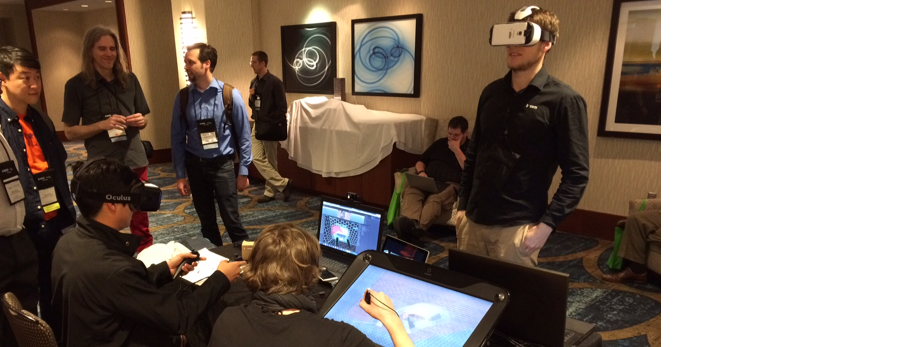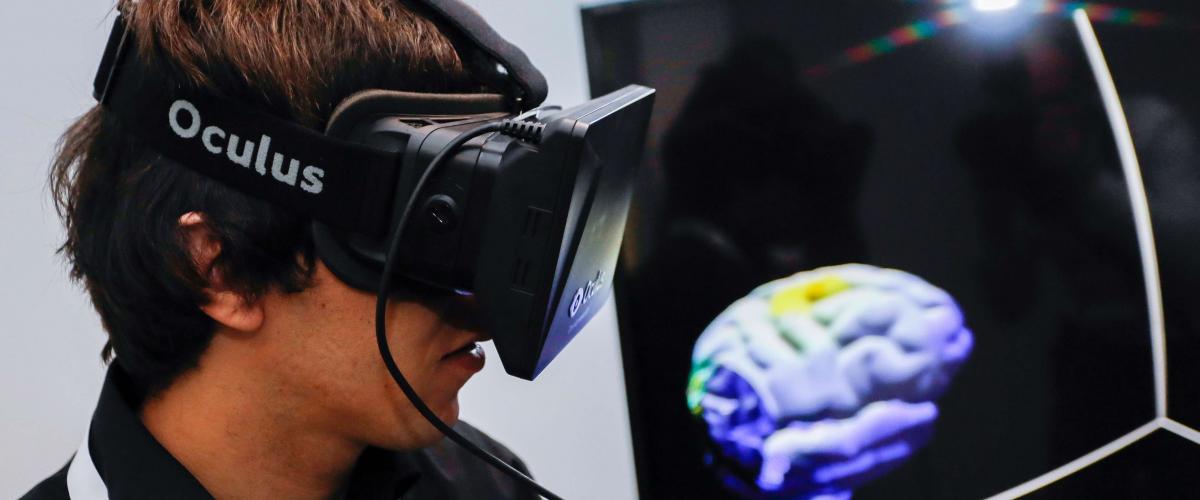The IEEE 3D User Interface and IEEE Virtual Reality conference was held in Greenville from March 19 to 23, with nearly 500 international researchers attending. At this event, b<>com took part in the 3DUI Contest, which each year sees the world's top research laboratories (University of Rio Grande do Sul, EPFL, University of São Paulo, Virgina Tech, etc.) compete in a 3D interaction challenge.
This year, the challenge consisted of several users through 3D interactions in order to move a cube through a tunnel. Jérémy Lacoche, Morgan Le Chénéchal, and the Immersive Interactions, Virtual/Augmented/Mixed Reality team at b<>com came in second during their very first time participating in the contest.
The Interaction
Jérémy and Morgan drew on the research work they have carried out for over 2 years in the Immersive Interaction lab in order to offer asymmetrical collaborative interaction through:
- The systems used: A "pseudo-holographic" zSpace tablet, an Oculus Rift DK2 virtual reality headset combined with a Razer Hydra interaction system with 6 degrees of freedom, a Samsung Gear VR headset, and a Google Cardboard set.
- Each user's viewpoints: The user on the zSpace had a global view of the environment and interacted with a second user equipped with a VR headset positioned virtually within the cube, and a third user equipped with the Samsung Gear VR positioned behind the cube. The user equipped with Google Cardboard, meanwhile, played the role of visitor, and could switch between viewpoints without being able to interact.
- The interactions: The user on the zSpace could translate the cube, the one on the Oculus Rift DK2 could turn the cube and change its size, and the one on the Samsung Gear VR could change the cube's size.
Using different visual effects that reduce nausea in virtual reality headsets and facilitating the perception of the virtual environment and of the other users, this demo was able to win over the jury members and all of the 3DUI conference attendees who were able to test the application and vote.

Why an asymmetrical immersive collaboration?
Usages that involve multiple users in an immersive environment interacting with shared virtual content are manifold: Immersive training, visualizing large quantities of data, telemaintenance, telepresence, design project reviews, surgical assistance systems, video games, and more. However, these users generally play different roles (trainer/learners, engineers/decision-makers, surgeons/senior experts/nurses, operator/maintenance expert, etc.), making it necessary to connect together immersive interaction systems perfectly suited to their needs. Additionally, the immersive systems available for those users vary greatly, from the Visiocube costing several hundred thousand euros, to a pseudo-holographic tablet costing several thousand euros, or to an inexpensive virtual reality headset or augmented reality glasses for professional uses, and rarely will all the users who are collaborating in the immersive environment have similar equipment to one another.
The solutions developed by b<>com to improve asymmetrical immersive collaboration
The framework drawn from Jérémy Lacoche's thesis research on the plasticity of mixed reality interfaces has made it possible to adapt the application developed for this contest in record time to four different systems, offering immersive interactions for each one that are perfectly suited to the needs of every user. Additionally, the thesis research of Morgan Le Chénéchal on the perception of remote users in immersive collaboration helped provide visual feedback during this contest that greatly improved self-perception as well as the perception of both other users and the virtual environment, and therefore the collaboration itself. Additionally, concurrent with the contest, the IEEE 3DUI conference was an opportunity to present research drawn from the theses of Jérémy Lacoche and Morgan Le Chénéchal in three sessions on 3D immersive interactions.
This result was made possible by calling on the expertise of the Immersive Interactions, Virtual/Augmented/Mixed Reality team, including that of Yann Carioun, a graphic designer at, b<>com, who worked over the 3D environment in order to provide quality content. It helps enhance the fame and credibility of b<>com on the international stage with respect to its ability to deliver quality innovation that relies on solid scientific and technological understandings.



